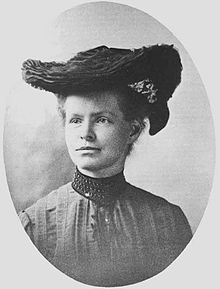Nettie Stevens
| Nettie Stevens | |
|---|---|
 |
|
| Born | Nettie Maria Stevens July 7, 1861 Cavendish, Vermont, United States |
| Died | May 4, 1912 (aged 50) Baltimore, Maryland, United States |
| Fields | Genetics |
| Education | Westford Academy |
| Alma mater |
Westfield Normal School Stanford University Bryn Mawr College |
| Doctoral students | Alice Middleton Boring |
| Known for | XY sex-determination system |
| Influences |
Edmund Beecher Wilson Thomas Hunt Morgan |
Nettie Maria Stevens (July 7, 1861 – May 4, 1912) was an early American geneticist. In 1906, she discovered that male beetles produce two kinds of sperm, one with a large chromosome and one with a small chromosome. When the sperm with the large chromosome fertilized eggs, they produced female offspring, and when the sperm with the small chromosome fertilized eggs, they produced male offspring. This pattern was observed in other animals, including humans, and became known as the XY sex-determination system. .
Nettie Maria Stevens was born on July 7, 1861, in Cavendish, Vermont, to Julia (née Adams) and Ephraim Stevens. After the death of her mother, her father remarried and the family moved to Westford, Massachusetts. She was graduated from Westford Academy in 1880.
Stevens taught high school and was a librarian. Her teaching duties included courses in physiology and zoology, as well as mathematics, Latin, and English. Her interest in zoology may have been influenced by taking a teacher training course she attended on Martha's Vineyard in the 1890s.
After teaching for three terms, she continued her education at Westfield Normal School (now Westfield State University) completing the four-year course in only two years and being graduated with the highest scores in her class.
After graduation at the top in her class, she attended Stanford University, where she received her B.A. in 1899 and her M.A. in 1900. She also completed one year of graduate work in physiology under Professor Jenkins and histology and cytology under Professor McFarland. Stevens continued her studies in cytology at Bryn Mawr College, where she obtained her Ph.D. and was influenced by the work of the previous head of the biology department, Edmund Beecher Wilson, and by that of his successor, Thomas Hunt Morgan. Her work documented processes that were not researched by Wilson and she used subjects that he later would adopt along with the results of her work.
...
Wikipedia
